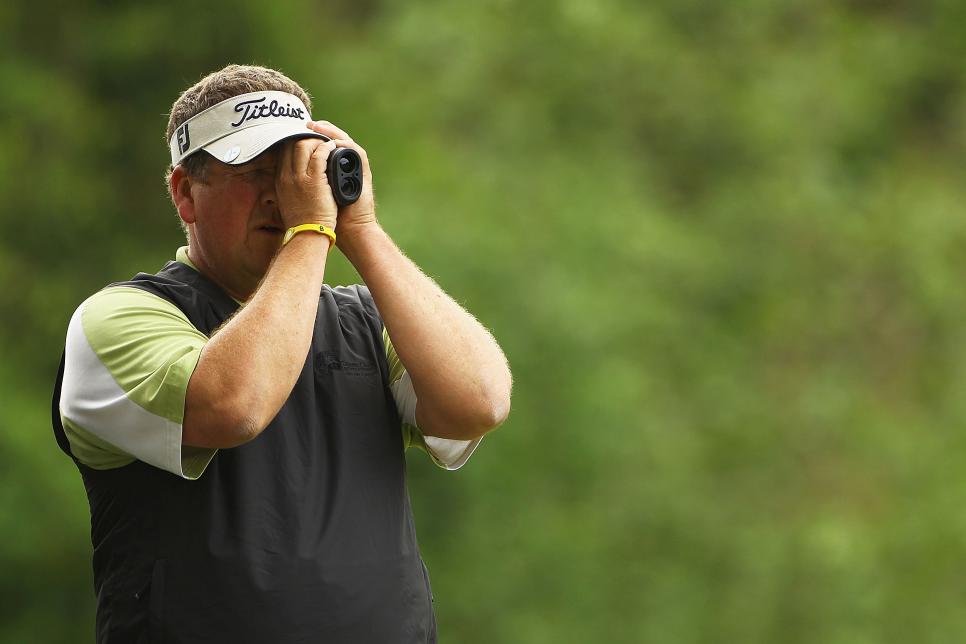News
The USGA and R&A show some heart with changes to the Rules of Golf

Among the changes to the Rules of Golf for 2016 is penalizing players who have illegal features on distance-measuring devices only if they use the features. (*Getty Images*)
Even the most rules-illiterate golfer knows about the ban on the anchored putting stroke that goes into effect Jan. 1, 2016. That’s what happens when officials with the USGA and R&A embark (wisely) on a 2½-year publicity blitz to make sure no one can accuse them of trying to slip by one of the most controversial rules revisions in recent memory.
As it turns out, however, that's not the only notable change golfers will see when the newest edition of the Rules of Golf becomes dogma for the next four years starting New Year’s Day. On Monday, the USGA and R&A jointly announced three other “significant” changes for the pending quadrennial, each the result of months (if not years) of healthy dialogue between the two governing bodies.
Long story short: The two groups aren’t always the cold-blooded, unbending sticks-in-the-mud we like to make them out to be on the rules. While taking something away from average golfers with the anchoring ban, the other three changes show those in charge are willing to be a tad bit less stodgy with how they view some of the rules.
Here is the layman’s interpretation of each change.
Withdrawal of Rule on Ball Moving After Address (Rule 18-2b)
Golfers will now be considered innocent until proven guilty—novel concept for sure—when it comes to being penalized for their ball moving after address. Rather than automatically being deemed to have caused the ball to move—and thus subject to a one-stroke penalty—only when the facts show that the player actually caused the ball to move (or more likely than not caused the ball to move) will he or she be subject to the penalty starting in January. This adds some subjectivity to various situations, but also allows some much-appreciated leniency.
Limited Exception to Disqualification Penalty for Submission of Incorrect Score Card (Rule 6-6d)
Thomas Pagel, senior director of rules and amateur status with the USGA, says this shouldn't be considered the “Tiger Woods Rule” as born out when Woods was allowed to play on at the 2013 Masters despite failing to access a two-stroke penalty after an improper drop during his second round and not be DQ’d for signing for a score that was too low. The way the change in the rule is written, however, it will allow players (like Woods) who are unaware before they sign their cards that the card is incorrect specifically because their score doesn’t include penalty strokes the players did not know they should be assessed not to be kicked out of an event. Instead they will be allowed to continue to compete after adding the penalty strokes to their score (any strokes for the unknown penalties plus two more strokes for signing the incorrect score card).
In all other cases in which a player returns a score for any hole lower than actually taken, the penalty remains immediate disqualification. "This is not going to cover simple math errors," says Pagel, who noted the discussion on this point has gone for years. "If you had a 5 and wrote down a 4, you will still be disqualified. This is only if you forgot to include a one- or two-stroke penalty that you did not know occurred. Whether it was ignorance of the rules or applying one stroke rather than two."
There are obvious ramifications for pros playing in tour events, but the rule will impact recreational golfers as well. Say during the member-guest at your club you hand in a score card after your opening round but when talking about that crazy incident on the 12th hole with your buddies over a beer afterward you realize you actually breached a rule that you didn't access yourself a penalty for. Previously you would have been DQ'd from the event, but now you can add the appropriate penalty and play on.
Modification of Penalty for Single Impermissible use of Artificial Devices or Equipment (Rule 14-3)
Again, here’s an instance where players had previously been penalized regardless of intent and are now going to be treated more leniently. If you had a device, such as a range finder, that has prohibited features under the rules, such as a wind gauge or slope monitor, it was presumed you were using those features and you were disqualified from a competition for using the device. The change to this rule allows for loss of hole in match play and a two-stroke penalty for a first offense in using the non-conforming device. Subsequent breaches of Rule 14-3, though, would result in DQ.
A beneficiary of this rule would have been D.A. Points, who at the 2014 AT&T Pebble Beach National Pro-Am was disqualified for using a foam ball under his arm while taking a practice swing during a wait in his round. Did the punishment really fit the crime? The USGA and R&A weren't quite so sure, and thus will cut golfers some slack.
Who says the blue blazers don't have a heart?